Civil War Hoarding Created a Need for the Nickel Three Cent Piece
Posted on — Leave a commentThe Civil War impacted nearly every aspect of Americans’ lives. Amid the military battles, food shortages, and economic chaos, people hoarded any precious metals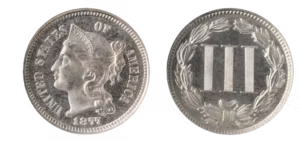 they could get their hands on. That included the three-cent silver piece, the smallest silver coin produced at that time by the U.S. Mint. This created a currency shortage for daily commerce and trade.
they could get their hands on. That included the three-cent silver piece, the smallest silver coin produced at that time by the U.S. Mint. This created a currency shortage for daily commerce and trade.
In an effort to ease the currency shortage, the U.S. Treasury issued small-denomination paper notes, ranging from three cents up to fifty cents. These paper notes became known as fractional currency. But the public distrusted and disliked paper currency.
A Distrust of Paper Currency Opened the Door to Using Nickel in Coins
In 1865, Congressman John Kasson, widely known for being against using nickel in coins, sponsored a bill to authorize a new three-cent coin made of nickel and copper. The reason Kasson changed his mind? He liked fractional currency even less than he liked nickel coins. The bill passed, and a new three-cent nickel coin was born.
The Philadelphia Mint struck nickel three-cent coins from 1865 through 1889. The public instantly embraced them, finding nickel three-cent pieces extremely convenient because they could be used to buy postage stamps, which cost three cents at the time.
1877 Nickel Three Cent Piece: A Key Date with a Tiny Proof Only Mintage
Collectors typically acquire the nickel three-cent piece as a type coin. However, within the series, there is a prominent and highly desirable proof-only mintage. In 1877, the Philadelphia Mint produced 900 proofs of the nickel three-cent piece, the lowest number of the entire series. Survivors are scarce.
Today, only 350 of the 1877 key date three-cent nickels are shown in grades 65 or better. See a prized 1877 Nickel three-piece coin here.
Coin Design
The original design adopted in 1865 remained unchanged for the 24 years the coin was produced. Chief Engraver James Longacre created the crisp and clean design. The obverse featured the head of Liberty facing left. She wears a beaded coronet carrying the word: LIBERTY. The date and UNITED STATES OF AMERICA encircle the obverse. The reverse is an impactful and simple design highlighting the Roman numeral III in the center, surrounded by a delicate wreath.
Cargo Ship Traffic from China to U.S. Drops 40%: What It Means For Gold
Posted on — Leave a commentWhen you shop at Target, Walmart, or Costco, you probably don’t think much about the journey the items you buy have taken.
It turns out that things made in China can travel up to 10,000 nautical miles to arrive on U.S. soil. Cargo ships carry everything from laptops, smartphones, furniture, lamps, clothing, toys, sports equipment, shoes, and more to the U.S., eventually landing in your neighborhood stores.
Since early April, when the U.S. added a 145% tariff on goods imported from China, cargo ship traffic has slumped. About 40 cargo ships are en route from China to the U.S., but that number is down by about 40% just before the tariffs were instituted. Those ships carry about 320,000 containers, according to Bloomberg. That’s about a third fewer than just before the 145% tariff was set.
Looking ahead, cargo ship traffic could slow even more. In late April, Hapag-Lloyd AG, the world’s fifth-largest container carrier, stated that approximately 30% of bookings from China to the United States have been cancelled.
While the trade war is still young, and although the U.S. has said the tariff rate on China will come down, trade is slowing now.
What does this mean for you, the economy, and gold?
By the middle of May, thousands of American companies, even giant retailers like Target and Walmart, will need to replenish inventories. Experts predict we may begin seeing empty shelves at some of your favorite stores in a couple of weeks.
The U.S. is a consumer-led economy. By some accounts, consumer spending creates roughly 70% of our gross domestic product. For the economy, the math is simple. Fewer goods to sell means less spending, slowing economic growth.
What about gold? The precious metal has soared almost 30% since the start of the year, at least partly fueled in large part by safe-haven buying amid stock market volatility, concerns over a recession, and the impact of the tariffs on the economy.
The price of gold keeps hitting record after record, recently surpassing $3,400 an ounce, and it’s still climbing. Many on Wall Street, including J.P. Morgan and Goldman Sachs, expect gold to hit $4,000 by 2026. However, given how fast gold has been climbing, $4,000 could come even earlier.
While many Americans haven’t yet seen firsthand the impact of the trade war, it could be coming within a few weeks. Logistics experts warn that springtime is when retailers begin placing orders for back-to-school and Christmas inventory. In a typical year, the first holiday shipments would be hitting the water and starting that journey by mid-May. For now, many of those orders have been canceled or are on hold.
While the jury is still out on any tariff deal between China and the U.S., fewer goods are coming to our country now. While that may put a crimp in back-to-school shopping, it will continue to support the historic climb in gold prices. Do you own enough?
Want to read more? Subscribe to the Blanchard Newsletter and get our tales from the vault, our favorite stories from around the world and the latest tangible assets news delivered to your inbox weekly.
Fed Issues Stark Warning on Economy
Posted on — Leave a commentThe Federal Reserve kept its key interest rate steady at 4.25-4.50% when it met on Wednesday. Nonetheless, Fed officials issued an unusually frank warning about what could lie ahead.
“Uncertainty about the economic outlook has increased further,” Fed officials said. “The committee… judges that the risk of higher unemployment and higher inflation have risen.”
How markets reacted
Gold traded sideways following the Fed’s meeting, while stocks traded lower. Gold has climbed over 26% since the start of 2025 as world investors have piled into the safety of gold.
The trend for gold points higher with major banks projecting big gains ahead for the precious metal. In a new research note today, Bank of America said it sees growing potential for gold to hit $4,000 an ounce in the second half of this year because of global trade-induced geopolitical uncertainty.
Quick primer: How the Fed uses interest rate policy
One of the main tools in the Fed’s toolbox is raising and lowering its key interest rate.
- Lowering interest rates helps boost an economy that is slowing down
- Raising interest rates helps tamp down inflation
The Fed’s dilemma Today, the Fed says the U.S. economy is staring at both of those risks ahead – the potential for economic slowdown or even a recession, and the risk that consumer prices and inflation could rise from the tariff policy. The U.S. economy is already slowing as first quarter Gross Domestic Product (GDP) growth declined by 0.3%.
What’s next? Stock investors are betting on interest rate cuts in the second half of 2025. By July, the CME FedWatch tool reveals that the market is pricing in 55% odds of a 0.25% interest rate cut.
Yet, the Fed is stuck between a rock and hard place, as economists worry that rate cuts could make inflation worse.
View from the Street on Economy and Stocks
In a new Barron’s Big Money poll, Wall Street money managers see risks for the stock market ahead.
- Sixty-five percent say the stock market will suffer a decline of 20% or more.
- Only 26% of money managers are bullish on the stock market over the next 12 months.
- Twenty-four percent say the biggest risk for the stock market over the next 6 months is an economic slowdown
- Nineteen percent say a recession is the biggest risk for the market over the next 6 months
Will You Act on the Fed’s Warning?
The Fed is warning of big economic risks ahead. Money managers are warning of a bear market in stocks this year. Is your portfolio positioned for what lies ahead? Central banks, pension funds, family offices and individual investors are turning to the safety of physical gold and silver. It’s easy to buy more portfolio protection with an increased allocation to gold. Why not do it today?
Protectionist Trade Policies Shine Spotlight on Gold As World Dumps Dollars and Treasuries
Posted on — Leave a commentGovernments and investors worldwide appear to be losing confidence in the U.S. dollar and U.S. Treasury bonds. The start of a new global trade war has rattled the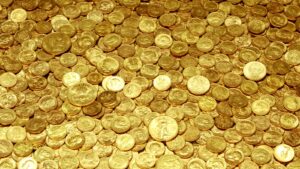 world as the rules around the global economic order have starkly changed in a matter of weeks. America’s move toward highly protectionist policies has triggered a stock market crash, a 9% decline in the U.S. dollar this year, and U.S. Treasury bonds are down too.
world as the rules around the global economic order have starkly changed in a matter of weeks. America’s move toward highly protectionist policies has triggered a stock market crash, a 9% decline in the U.S. dollar this year, and U.S. Treasury bonds are down too.
As the world’s financial faith in the U.S. has been rattled, global investors are pulling out of U.S. assets. Why is this significant?
In the past, during times of economic and financial crisis, investors around the globe bought the U.S. dollar and U.S. Treasury bonds as safe-haven investments. Now, they are selling the U.S. dollar and selling U.S. bonds.
Gold has now moved to the top step as the world’s ultimate safe-haven asset. In April, gold set new all-time highs above $3,400 an ounce as the flight to safety poured into the precious metals markets.
It’s worth considering that the U.S. policies are changing at a time when our nation owes a lot of money. The U.S. national debt tops $29 trillion. In fiscal year 2025, the Congressional Budget Office forecasts a budget deficit totaling $1.9 trillion. To fund our deficit and debt, our nation relies on capital inflow from foreign governments and investors.
In a new economic world order where the U.S. isn’t seen as a reliable partner, it makes sense for foreign investors to diversify their holdings away from U.S. assets, experts say. Indeed, it’s already starting to happen. According to Bank of America, foreign investors accounted for a smaller share of buyers at March Treasury auctions.
Foreigners own roughly 20-30% of the U.S. stock and bond markets, totaling about $19 trillion of U.S. equities, $7 trillion of Treasuries, and $5 trillion of U.S. corporate bonds, according to Apollo Management. A wholesale reversal of capital inflows to American markets could cause significant economic pain, fresh stock market losses, and significantly higher interest rates.
In the meantime, gold is increasingly seen as the only safe haven game in town. Goldman Sachs Group now projects that gold could climb to $3,700 by the end of this year. If the U.S. economy slips into recession, the firm projects gold hitting $3,880 this year. Looking into the middle of next year, Goldman expects gold to climb to $4,000 an ounce.
The U.S. economy isn’t out of the woods yet. The dust hasn’t even begun to settle. In closed-door meetings at the White House, the chief executives of Walmart and Target privately warned the President that tariff policy could result in empty shelves in their stores in the weeks ahead. If you are looking to take steps to protect your hard-earned assets, explore our gold inventory now. Gold at $4,000 may be here faster than you expect.
Want to read more? Subscribe to the Blanchard Newsletter and get our tales from the vault, our favorite stories from around the world and the latest tangible assets news delivered to your inbox weekly.
1862 Indian Head Cent: James Longacre’s Civil War Masterpiece
Posted on — Leave a commentJames B. Longacre, Chief Engraver of the U.S. Mint, is best remembered today for his creation of the iconic Indian Head cent.
The 1862 Indian Head cent was struck during a pivotal phase of the Civil War, which saw a shift in momentum and strategic gains for the Union Army. Major battles included the Battle of Shiloh in Tennessee, the Union capture of New Orleans, and the Seven Days Battles outside Richmond. The bloody Battle of Antietam in September 1862 had no clear winner. But this significant Civil War battle opened the door for President Lincoln to announce the Preliminary Emancipation Proclamation.
Indian Head cents are a classic early American coin coveted by collectors due to their design, historical significance, and rarity. Minted from 1859 through 1909, Indian Head cents were produced in large numbers in most years.
In 1862, against the backdrop of a war-torn nation, the Philadelphia Mint produced 28,075,000 Indian Head cents. The production met huge demand for small change in the cash-starved economy. Amid the chaos of wartime, citizens were hoarding precious metals.
While the 1862 cents’ mintage was substantial, survival rates tell a different story. Most coins circulated heavily, leaving few in pristine condition.
Today, a mere 400 survivors are estimated in grades 65 or better.
In 1909, the Indian Head cent was replaced by the Lincoln cent, designed by Victor D. Brenner, closing this important era in U.S. numismatic history.
Longacre’s vivid design features a representation of Liberty wearing an Indian headdress, blending classic artistry with frontier imagery. The obverse includes the word “LIBERTY” on the Native American headdress, encircled by “UNITED STATES OF AMERICA” and the date “1862″ at the bottom.
The reverse features an intricately beautiful oak wreath encircling the coin’s denomination “ONE CENT.” A small shield sits at the top, symbolizing victory. The 1862 Indian Heads are known for being usually well-struck and with excellent luster. The 1862 Indian Cent was struck with an alloy of 88% copper and 12% nickel, creating the coin’s pale hue. It clocks in with a substantial weight at 4.67 grams.
Today, collectors interested in Civil War history and early American coinage jump at the opportunity to own an Indian Head cent, a tangible piece of early American history. Whether you desire to acquire a coin like this as a standalone treasure or part of a larger collection, this rarity is a testament to the enduring legacy of early American coinage. Blanchard has one of these magnificent coins on offer now. See it here.
Read more
Copper Shortage Paves Way for Small Flying Eagle Cent
Top 5 Rare Coins You Should Collect
Want to read more? Subscribe to the Blanchard Newsletter and get our tales from the vault, our favorite stories from around the world and the latest tangible assets news delivered to your inbox weekly.
Gold Soars Past $3,300 to New Record High: What the Pros Say Comes Next
Posted on — Leave a commentGold’s record-breaking rally is continuing at breakneck speed as the tariff war with China escalates. The precious metal has surged roughly $700+ an ounce this year, driven higher by the tariff war, concerns over the potential for global recession, and expectations that the Federal Reserve will cut rates.
As many investors seek safety amid a stock market crash and reshuffling of the geopolitical and economic world order, gold investors may ask: What comes next?
In a matter of weeks, gold has breached the $3,400 an ounce target set by many Wall Street firms for 2025. However, many economic experts warn that the global order is undergoing a regime change, with outcomes and results that aren’t known yet. That has dramatically increased interest in the safety and security of gold as a store of value, a hedge against inflation, and a vehicle to protect wealth.
Here’s what some of the Wall Street pros are saying now.
“In the short to medium term, a combination of heightened global economic tensions, the risk of stagflation, and a weaker dollar may continue to support bullion. We raise our 2025 forecast for gold to USD 3,500 per ounce.” Saxo Bank – April 16, 2025
Forty-two percent of fund managers expect gold will be the best-performing asset of 2025, according to Bank of America.” – Yahoo Finance, April 16, 2025
“We’re putting in a pretty good base now around $3,000,” Mike McGlone, Senior Commodity Strategist at Bloomberg Intelligence. “It’s going to head into $4,000.” Kitco News – April 14, 2025
“A bunch of factors could push gold still higher,” said Michael Cuggino, president and portfolio manager of Permanent Portfolio Family of Funds. “They include U.S. political uncertainty, buying of gold by foreign central banks, the risk of U.S. inflation, lower interest rates, and a weakening dollar. All of these things add up to a pretty strong case for gold.” – Barron’s, April 14, 2025
Gold $6,000?
“Gold could double over the next five years. It is always a ballast in a portfolio, and it is inversely correlated to other assets, so it is an effective hedge,” said David Rosenberg, founder, Rosenberg Research & Associates, who was one of the few who predicted the global financial crisis of 2008-2009.
“If you reset global trade and want to talk about the laws of unintended consequences, for the first time in my life, the U.S. could relinquish its reserve currency status. That is on the table,” Rosenberg said.
“What would replace the dollar is an open question, but this is the road we are being led down. And if we start to have this reset of global trade, a $6,000 view on gold within the next five years could end up being a conservative estimate. So, I still like gold.” – Barron’s April 15, 2025
Want to read more? Subscribe to the Blanchard Newsletter and get our tales from the vault, our favorite stories from around the world, and the latest tangible assets news delivered to your inbox weekly.
Blanchard in the News: Wall Street Journal Highlights Gold’s Explosive Growth
Posted on — Leave a commentEveryone is a gold bug now, according to a new Wall Street Journal article, which featured Blanchard. It’s no surprise that gold is making headlines. The precious metal has soared an extraordinary 20%+ since the start of the year, while the U.S. stock market has tanked.
What’s notable about the latest wave of gold buying is that it attracting a new generation of buyers, according to the Wall Street Journal:
The metal is attracting first-time buyers, many younger than traditionally seen, seeking a stable investment as Trump’s policies rattle the stock market and escalate global political tensions. Other longtime devotees are increasing their holdings.
“Owning physical gold is moving more toward the mainstream.”
Blanchard has also noticed gold gaining followers during the dot-com bubble, the 2008 financial crisis, and the COVID-19 pandemic.
New Generation Embraces Blanchard’s Investing Philosophy
Younger Americans are recognizing the value of the key investment principle that Blanchard has employed with our clients for the past 50 years:
- We believe that gold and silver bullion in physical form is an appropriate asset for a small portion of any properly diversified investment portfolio.
In other words, everyone should own physical metals. Other key tenets of the Blanchard tangible assets investment approach are:
- Everything we do is based on a long-term outlook.
- We believe in the long-term investment value of high-end rare and ultra-rare coins.
- We take the time to understand your investment objectives, time horizon, and risk appetite before recommending products for your consideration.
Historic Multi-Year Gold Rally Is Underway
Both long-time gold owners and first-time buyers are benefiting from an explosive rally in the gold market, one of the most significant seen in decades. This is a continuation of the uptrend we’ve seen in recent years. In 2024, the price of gold set forty record highs and finished the year with a 27% gain.
This year, gold continues to make history. In March 2025, gold hit a major milestone as it soared above the $3,000 barrier for the first time and then quickly eclipsed the $3,100 level. Year-to-date, gold has sprinted 20%+ higher and is still climbing. This year marks the fourth consecutive year that gold has reached new all-time highs.
What’s Driving Gold Higher Now?
Gold and silver are both benefiting from a massive flight to safety in 2025.
On April 2nd, deemed Liberation Day, the White House rolled out tariff increases of 10% to 50% on most trading partners. The expansive tariffs spooked the market amid worries that corporate profits could turn south. Some economists bumped up their recession odds forecast to 50% following the tariff news. The price increase from tariffs is expected to mean less disposable spending power in American consumers’ pockets, slowing economic growth and hiring.
The jury is still out on how the tariffs will impact the economy, but some American business owners have expressed concern about current supply channels that could become more costly.
Gold Offers Safe Haven
In the meantime, the safety of gold and silver is appealing. Gold has served as a store of value for 5,000 years and is a proven vehicle to protect and grow your wealth, especially during uncertain economic times. Because gold has a low correlation to the stock market, when stock prices crash, gold prices historically soar. Here’s a snapshot of just a few of the major indices and selected stock price performance.
Year-to-date performance
Winners
- Gold up 22%
- Silver up 16%
Losers
- Nasdaq Composite Index down 14%
- S&P 500 Index down 8%
- Nvidia down 23%
- Nike down 26%
- Dell down 32%
- Best Buy down 27%
- Williams Sonoma down 25%
- Wayfair down 45%
- Norwegian Cruise Lines down 36%
- Advanced Micro Devices down 22%
Gold Is Still Climbing
What we are seeing now is just the start of the current gold rush. As highlighted in the Wall Street Journal, Bank of America analysts raised their price target to $3,500. Do you own enough?
Want to read more? Subscribe to the Blanchard Newsletter and get our tales from the vault, our favorite stories from around the world, and the latest tangible assets news delivered to your inbox weekly.
Bullion Exempted in Liberation Day Tariffs: What This Means for Gold Investors
Posted on — Leave a commentAs the world digests the impact of the White House’s Liberation Day tariffs, an exemption for metals—including bullion—tucked quietly inside the White House fact sheet. Let’s dig into the details.
According to the White House fact sheet released on April 2nd, metals are exempt from the reciprocal tariff. You can read this exemption in section (5) below. Bullion refers to precious metals like gold and silver in bulk form, like gold bars or coins.
“Some goods will not be subject to the Reciprocal Tariff. These include: (1) articles subject to 50 USC 1702(b); (2) steel/aluminum articles and autos/auto parts already subject to Section 232 tariffs; (3) copper, pharmaceuticals, semiconductors, and lumber articles; (4) all articles that may become subject to future Section 232 tariffs; (5) bullion; and (6) energy and other certain minerals that are not available in the United States.”
How Did Precious Metals React to the News?
Gold and silver prices tumbled sharply on the tariff exemption. This can be confusing even for the most seasoned investors. It’s complicated.
The sharp pullback in precious metals relates to a massive arbitrage trade occurring in recent weeks as traders rushed to get gold and silver out of London vaults to the U.S. ahead of the expected tariffs. Planes and ships have been loaded with bullion as U.S. firms and banks rushed to get gold and silver to the U.S.
The unexpected tariff exemption for bullion caused the premium for gold and silver to fall, resulting in lower prices. However, prices have soared back to new records as Friday, April 11th.
Here’s how a Bloomberg news article described it: “On Thursday, US premiums for precious metals tumbled after a list of exemptions from the tariffs included gold, silver, platinum and palladium. The difference between front-month Comex gold and spot gold in London dropped to $21 an ounce from over $62 on Wednesday. For silver, the differential — known by precious metals trader as the “exchange for physical” or EFP — tumbled from more than $1 an ounce to just 8 cents.”
What Does This Mean for Gold and Silver Investors Now?
Gold has soared more than 20% since the start of 2025 as investors around the globe have piled into the safety of precious metals. In a world where the U.S. dollar is falling, the stock market is crashing, and bond yields are in decline, there are few places for investors to turn to protect and preserve their wealth. Precious metals are a safe haven in the economic storm of uncertainty. The surprise tariff exemption for metals created a short-term dislocation in gold and silver prices as the premiums collapsed.
Bottom line? This is a short-term dip buying opportunity for long-term precious metals investors that won’t last long.
The underlying uptrend in gold and silver prices hasn’t changed, and the reason investors big and small have been rushing into gold this year hasn’t changed. If anything, the economic and market uncertainty has increased.
Recession and Bear Markets Rise
Following Liberation Day, J.P. Morgan raised its odds for a U.S. and global recession to 60% this year. S&P Global, Goldman also hiked U.S. recession probabilities following the new White House tariff policy, which imposed tariffs on dozens of countries around the globe. On April 4, the Nasdaq Composite traded more than 20% off its December high. Sustained declines of 20% or more is the definition of a bear market in stocks.
If you have money invested in the market, there is no historical playbook over the last 100 years for what the sweeping tariff policy changes will mean for the U.S. economy. Uncharted economic waters lie ahead, and the waves of selling likely aren’t over. The U.S. stock market hasn’t fully priced in a recession yet.
Trade Your Dollars for Bullion Now
Morgan Stanley predicts that gold could reach $3,400 in 2025, Bank of America raised its forecast to $3,500, and Goldman Sachs said gold could reach $4,500 in a low probability “extreme tail scenario.” There are few places investors can park their money in 2025 for wealth preservation and growth—and precious metals offer you that opportunity today.
Want to read more? Subscribe to the Blanchard Newsletter and get our tales from the vault, our favorite stories from around the world, and the latest tangible assets news delivered to your inbox weekly.
Current Geopolitical Risks and How They Influence the Price of Gold
Posted on — Leave a commentWhen conflicts arise or economic systems face pressure, investors frequently turn to gold as a store of value. Today, we find ourselves in a period of significant geopolitical risks. From ongoing tensions in Eastern Europe to conflicts in the Middle East and evolving trade relationships between major powers, the global landscape is marked by uncertainty. Many investors question how these developments influence the price of gold in both short and long-term scenarios. This article aims to shed light on the relationship between geopolitical events and gold prices by discussing:
geopolitical risks. From ongoing tensions in Eastern Europe to conflicts in the Middle East and evolving trade relationships between major powers, the global landscape is marked by uncertainty. Many investors question how these developments influence the price of gold in both short and long-term scenarios. This article aims to shed light on the relationship between geopolitical events and gold prices by discussing:
- How geopolitical events affect gold.
- Future geopolitical risks and their potential impact on gold markets.
- Investing in gold through trusted dealers like Blanchard.
Watch this informative video to find out more about how geopolitics affect the price of gold
How Geopolitics Affect the Price of Gold
Throughout human history, financial markets have responded dramatically to world events and political shifts. Investing in gold during crises has been a consistent strategy for wealth preservation when uncertainty strikes. Here, we will explore not only how gold responds to global instability but also why it continues to attract investors during turbulent times. Understanding these dynamics can help investors make more informed decisions about precious metals allocation in their portfolios.
Geopolitical Risks and Their Influence on Markets
Geopolitical risks fundamentally alter investment landscapes across the globe. When nations face political tensions, armed conflicts, or economic sanctions, market participants react swiftly, often triggering volatility across asset classes. These disruptions can manifest as currency devaluations, stock market corrections, or commodity price spikes. Given the interconnected nature of the global economy, regional conflicts rarely remain isolated – trade disruptions, energy price fluctuations, and supply chain interruptions can quickly spread economic impact worldwide. This ripple effect often leads investors to reassess risk exposure.
Throughout history, certain patterns have emerged during geopolitical crises. Equity markets typically experience increased volatility, while government bonds from stable nations attract capital flows. At the same time, commodities – particularly precious metals – see increased demand.
Gold, with its limited supply and universal value recognition, becomes especially attractive when currency stability comes into question. In response to these risks, central banks also adjust their strategies, diversifying reserves through increased gold purchases. This is evident in actions by institutions like the People’s Bank of China, which seek alternatives to dollar-denominated assets.
Why Gold is a Safe Haven Asset
Gold stands apart from most investment assets due to its enduring ability to maintain value during turbulent periods. Among safe haven assets, gold has demonstrated remarkable resilience through centuries of economic and political upheaval. Unlike currencies or securities, gold cannot be devalued through government policy decisions or corporate failures.
Several key attributes explain gold’s safe haven status. First, gold has intrinsic value independent of any issuing authority. Second, it offers portfolio diversification, typically moving inversely to stocks during market stress. Third, gold maintains high liquidity even during crises, allowing investors to convert holdings to cash when other markets freeze.
Gold’s price history confirms these protective qualities. During the 2008 financial crisis, gold appreciated approximately 25% while equity markets collapsed. Similarly, when the COVID-19 pandemic struck in 2020, stimulus measures and economic uncertainty pushed gold to record highs above $2,000 per ounce. Recent market events continue to reinforce gold as a safe haven, with prices climbing above $3,000 in early 2025 as U.S. technology stocks tumbled amid Chinese AI competition.
Geopolitical events consistently trigger gold price movements. The 1973 oil crisis saw gold prices triple. The 2014 Crimea annexation drove a 14% increase in gold prices. More recent conflicts in Eastern Europe and the Middle East have also produced notable, if temporary, price spikes.
Central banks recognize these properties, increasing their gold reserves substantially in recent years as a hedge against both geopolitical uncertainty and potential dollar depreciation.
Historical Trends: How Past Geopolitical Events Moved Gold Prices
Examining historical gold price trends reveals consistent patterns when major geopolitical events unfold. These patterns provide valuable insights into how gold might respond to future crises, though the magnitude and duration of price movements have varied considerably.
The 1979 Soviet invasion of Afghanistan contributed to gold prices rising sharply, culminating in a peak of $850 per ounce in January 1980 – a 66% increase over previous months. Similarly, when Iraq invaded Kuwait in 1990, gold jumped 15% within two months. The September 11 attacks in 2001 prompted a swift 6% price increase in the immediate aftermath.
Nevertheless, not all geopolitical events impact gold equally. In the lead-up to the 2003 Iraq War, gold prices rose approximately 4% in the month before the conflict, peaking near $385 per ounce. However, once military operations began, gold quickly declined by over 15%, demonstrating the “buy the rumor, sell the news” phenomenon that occasionally characterizes gold markets.
More recently, conflicts in Ukraine initially drove significant gold appreciation, with prices rising about 10% due to geopolitical factors. However, these gains were limited as market participants adjusted their expectations.
The data consistently shows that while geopolitical events frequently trigger immediate gold price increases, the sustainability of these gains depends heavily on broader economic conditions and monetary policy. Particularly notable is how Federal Reserve interest rate decisions often determine whether conflict-driven gold rallies persist or fade, with higher rates typically constraining long-term price appreciation.
Predictions: How Future Geopolitical Risks Might Shape Gold Markets
Forecasting market trends requires analyzing both established patterns and emerging global risks. Experts generally agree that several developing situations merit close attention when it comes to developing gold investment strategies in the coming years.
The evolving relationship between major powers, particularly the United States and China, represents a significant variable. Economic competition, technology restrictions, and potential Taiwan-related tensions could all trigger market volatility favorable to gold. Similarly, ongoing conflicts in Eastern Europe and the Middle East may periodically influence prices, especially if they threaten energy supplies or shipping routes.
However, the Federal Reserve’s monetary policy will likely remain the dominant factor influencing gold market trends. While geopolitical events typically provide short-term price catalysts, interest rate levels determine long-term price sustainability. Analysts suggest watching for signs of rate reductions, which would likely provide substantial support for gold prices.
Central bank purchasing behavior represents another critical indicator. If institutions continue diversifying reserves away from the U.S. dollar, as seen with China’s recent acquisitions, this consistent demand could establish higher price floors for gold.
Investors should monitor inflation trends particularly closely, as real, inflation-adjusted interest rates historically show the strongest correlation with gold prices. Additionally, they should watch for signs of market stress in traditional investments, which often precede capital flows toward gold as a protective mechanism against broader instability.
Conclusion
The interplay between geopolitical risks and gold prices presents valuable insights for investors navigating uncertain markets. While short-term price fluctuations often follow global crises, long-term trends depend on a complex interplay of central bank policies, inflation rates, and international currency dynamics.
Gold as an investment offers unique advantages during turbulent times. Its historical performance demonstrates resilience when traditional assets falter, providing both wealth preservation and potential appreciation opportunities. For those concerned about current market volatility, precious metals allocation can serve as a stabilizing force within diversified portfolios.
Those interested in investing in gold can visit Blanchard’s gold purchasing page to explore a selection of investment-grade coins and bars, with options suitable for every budget and strategy. The company’s expert advisors can help select the right products to meet specific financial goals and risk tolerance. Investors should also regularly monitor the price of gold today to make informed timing decisions.
FAQ Section
1. How do geopolitical risks affect gold prices?
Geopolitical risks typically drive the price of gold higher as investors seek safety amid uncertainty. When conflicts, trade disputes, or political instability threaten financial markets, gold often experiences increased demand. This relationship has been demonstrated repeatedly throughout history, from the Cold War era to present-day tensions. However, the magnitude and duration of price increases depend on multiple factors, including the severity of the crisis, market expectations, and prevailing monetary conditions.
2. Why is gold considered a safe-haven asset?
Investors have long valued gold as a safe haven because it maintains value independent of government stability or corporate performance. Unlike paper currencies, gold cannot be devalued through inflation or monetary policy. It has a negative correlation with most traditional investments during market stress, providing crucial portfolio diversification when it is most needed.
3. Can gold prices drop despite geopolitical tensions?
Yes, the price of gold today can decline even during geopolitical crises if other market factors exert stronger downward pressure. For instance, rising interest rates can make non-yielding assets like gold less attractive compared to income-producing investments. Strong dollar performance also typically weighs on gold prices. Moreover, when investors need liquidity during market panics, they sometimes sell gold holdings to cover losses elsewhere.
4. How does inflation impact gold prices?
Historical gold price trends show a generally positive correlation with inflation, particularly during periods of elevated price growth. Gold’s strongest performance typically occurs when real interest rates turn negative, eroding the purchasing power of cash and bonds. However, the relationship isn’t perfectly linear. During periods of moderate inflation with high interest rates, gold can struggle as income-producing assets become more attractive. The key metric for investors to watch is real yields on government bonds, which historically show a stronger correlation with gold than headline inflation figures alone.
5. Where can I buy gold as an investment?
When it comes to buying quality precious metals, working with established dealers with strong industry reputations and transparent pricing structures is paramount. Blanchard offers investment-grade gold coins and bars that meet exacting standards for purity and authenticity, backed by a company with over 40 years of experience in the precious metals industry. For those seeking gold as an investment, contacting Blanchard is an excellent first step toward building a precious metals portfolio. Blanchard’s team of experts can help determine the most appropriate products based on investment goals, budget, and risk tolerance, along with secure storage solutions and liquidation assistance when the time comes to sell.
Want to read more? Subscribe to the Blanchard Newsletter and get our tales from the vault, our favorite stories from around the world, and the latest tangible assets news delivered to your inbox weekly.
6 Best Silver Bars to Stack in Times of Crisis
Posted on — Leave a commentHistory has consistently shown that precious metals are a reliable haven during times of crisis. With geopolitical tensions and economic uncertainties currently reshaping the global landscape, today’s world is more complex and unpredictable than ever. For this reason, savvy investors are turning to precious metals to protect their wealth, with silver emerging as an exceptionally attractive option. This article will explore the best silver bars to buy, highlighting:
- 1 oz silver bars that are perfect for beginners.
- High-value bars for serious investors.
- The best place to buy silver bars online.
Silver Bars Worth Collecting
When it comes to protecting one’s wealth, understanding market trends is crucial. Learning the best way to buy silver bars is vital, as many financial experts suggest. Below are some of the most popular silver bar options available through Blanchard.
1. Best silver bars to buy: the classic 1 oz. option
1 troy-ounce silver bars offer an excellent entry point for new investors, combining quality and affordability. Their standardized weight has driven their popularity since the late 20th century, making them an accessible way to own physical silver. These .999 fine silver bars feature clean, elegant designs, typically displaying the mint’s logo, weight verification, and a unique serial number. To secure the best price on silver bars like these, investors should monitor market fluctuations before purchasing from a trusted dealer like Blanchard.
1 Troy Ounce Silver Bar (W/Assay, Types Vary)
- Metal: Silver
- Year: N/A
- Check our most current price here.

2. 1 oz silver bars: a patriotic investment choice
Featuring an intricate American flag design, the 1 oz. flag silver bars blend patriotic symbolism with precious metal investment. As some of the best silver bars to buy, they appeal to those who value both national pride and intrinsic worth. Each .999 fine silver piece showcases the 50 stars, symbolizing the original colonies. This unique fusion of investment value and American heritage makes them especially attractive to collectors and investors seeking precious metals that reflect national ideals.
1 oz Flag Silver Bars
- Metal: Silver
- Year: N/A
- Get our most current price here.

3. Best silver bars for mid-size investment: 5 oz bars
The 5 oz silver bar is an economical way to invest in precious metals, offering better value than smaller units. 5 oz silver bars best price points reflect their cost-efficient nature, as larger bars typically come with lower premiums per troy ounce than coins or smaller units. Each bar contains .999 fine silver and comes with an assay certificate from respected manufacturers. While their designs can vary from simple to intricate, all maintain the same high-quality silver content and trusted manufacturing standards.
5 oz Silver Bar (Types Vary)
- Metal: Silver
- Year: N/A
- View our most current price here.

4. Best 10 oz silver bars to buy for portfolio building
10 oz silver bars are a strategic choice for investors seeking better value. They are considered the best silver bars by those looking to accumulate larger amounts while avoiding the higher premiums of 1 oz units. Manufactured by both sovereign mints and private refiners, these .999 fine silver bars combine affordability with practical storage benefits. Their standardized size makes them easy to stack in safes or safe deposit boxes, while their established weight ensures smooth trading.
10 oz. Silver Bullion Bars (Types and Conditions Vary)
- Metal: Silver
- Year: N/A
- See our most current price here.
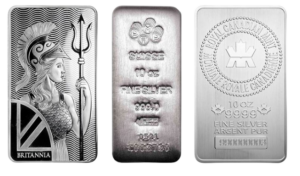
5. Best silver bars to buy for global portfolios: the premium kilo choice
The 1-kilo silver bar is a great option for international investors, being the global standard unit in many markets worldwide. The best way to buy silver bars for those seeking international flexibility, these 32.15 oz units are widely recognized across borders. Each .999 fine silver kilo bar features the manufacturer’s logo and weight verification in both grams and troy ounces, making them easily tradeable in any market. Their stackable design and anti-counterfeiting patterns ensure secure storage, while their standardized metric weight makes them particularly appealing for global portfolio diversification.
1 Kilo Silver Bar (Types and Conditions Vary)
- Metal: Silver
- Year: N/A
- Check our most current price here
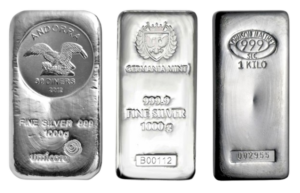
6. Best silver bars to buy for investment: 100 oz bars
100-oz silver bars stand as the industry standard for substantial silver holdings. They are some of the best silver bars to buy for investment purposes when seeking the lowest possible premiums over spot price. These bars are produced by prestigious manufacturers, including sovereign mints like the Royal Canadian Mint and private refiners such as Credit Suisse and PAMP Suisse. Each bar features identifying marks, including the manufacturer’s name, weight, purity, and unique serial number, with textured backing for easy stacking. Available in both struck and poured varieties, these bars are IRA-acceptable when meeting purity standards, making them an excellent choice for serious silver investors.
100 Oz Silver Bars (Types Vary)
- Metal: Silver
- Year: N/A
- Have a look at our most current price here
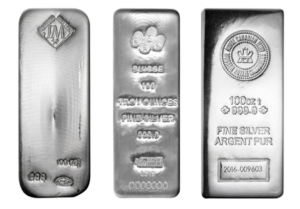
Browse Blanchard’s complete silver collection – the best place to buy silver bars and a trusted source for all precious metals
Where to Find Best Silver Bars (FAQ)
Here are the answers to the most common questions investors ask about buying silver bars.
-
Why are silver bars a good option during a crisis?
Silver is an excellent investment option during times of crisis because it is a reliable store of value when traditional financial systems face uncertainty. During economic downturns, geopolitical tensions, or currency devaluation, silver maintains or increases its purchasing power, unlike paper currency.
Silver bars, in particular, have distinct advantages over other forms of the precious metal during turbulent times. Firstly, they are typically more cost-effective than coins as they generally carry lower premiums over the spot price. Moreover, their standardized weight and purity make them easily tradeable and universally recognized, which is crucial when markets are volatile. Storage is also straightforward and secure, with bars being stackable and compact compared to collections of smaller units.
-
How can I check the authenticity of silver bars?
Verifying the authenticity of silver bars is crucial for protecting one’s investment, and there are several reliable methods to ensure you’re purchasing genuine silver. The first and most important step is buying from reputable dealers like Blanchard, who provide assay certificates confirming the bar’s authenticity and specifications. These certificates contain vital information, including the bar’s weight, purity, serial number, and manufacturer.
In addition to that, physical inspection can also help verify authenticity. Genuine silver bars should have clear, precise markings showing the manufacturer’s name, logo, weight, purity (.999 fine silver), and unique serial number. Many bars feature security elements like textured patterns or distinctive designs that make counterfeiting more difficult. A magnet test can provide additional confirmation, as silver is not magnetic – if a bar attracts a magnet, it’s not pure silver. For ultimate peace of mind, professional dealers also use specialized equipment like ultrasound machines or XRF analyzers to verify the metal’s purity without damaging the bar.
-
Can I easily sell silver bars easily?
Silver bars are among the most liquid precious metal investments available, making them easy to sell when needed. Their standardized weights, well-established purity standards (.999 fine silver), and universal recognition contribute to their high marketability.
However, it should be added that the ease of selling depends partially on the size of one’s bars. 1 oz, 5 oz, and 10 oz bars are particularly liquid due to their manageable size and lower price points, making them accessible to more buyers. Larger bars like kilos and 100 oz units might have a slightly smaller buyer pool but still maintain strong liquidity.
-
How do I store my silver bars safely?
Proper storage of silver bars is crucial for maintaining both their condition and security. There are several safe storage methods, each with its own advantages. The most common approach for personal storage is a high-quality home safe. For larger collections or higher-value holdings, bank safe deposit boxes offer institutional-grade security.
Regardless of storage method, it’s important to keep bars in their original packaging or protective sleeves to prevent scratching and tarnishing. While silver is durable, proper storage protects both its condition and value over the long term.
-
Can I buy silver bars with cryptocurrency?
Yes, Blanchard accepts cryptocurrency as payment for silver bars, making it convenient for digital currency holders to diversify into physical precious metals. The purchase process is straightforward: simply select your desired silver bars through the website and choose cryptocurrency as your payment method during checkout. The entire process is designed to be seamless, allowing you to diversify your investment portfolio efficiently while maintaining the highest standards of security and service.
For more insights into silver’s strong performance and promising outlook, read a thorough analysis on Blanchard’s – the best place to purchase silver bars – blog here.
Investing in silver bars is a time-tested strategy for preserving wealth, particularly during uncertain economic times. From the accessible 1 oz bars perfect for beginning investors to the internationally recognized kilo bars for global portfolios, and the industry-standard 100 oz bars for substantial holdings, there’s a silver bar option for every investment goal.
The key to successful silver investment lies not just in choosing the right bars but also in working with a trusted dealer. Blanchard stands out in the precious metals industry thanks to its rigorous authentication processes, secure storage guidance, and many decades of trusted expertise.
Want to read more? Subscribe to the Blanchard Newsletter and get our tales from the vault, our favorite stories from around the world, and the latest tangible assets news delivered to your inbox weekly.








